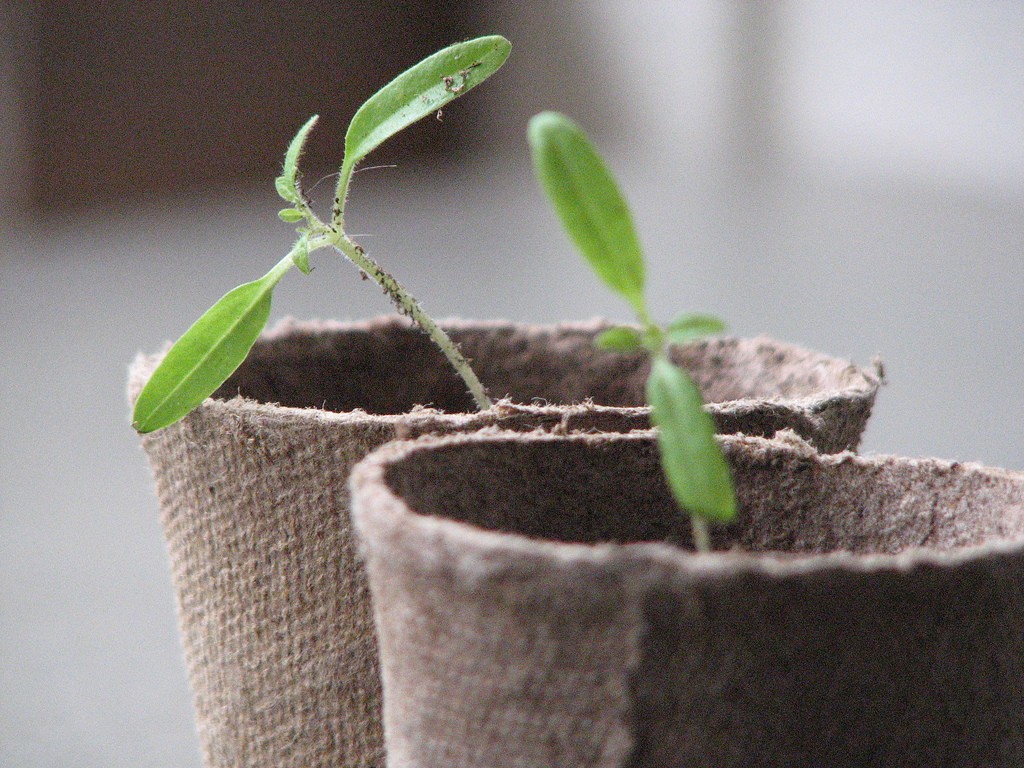Timing is important when starting seeds indoors

Tomato starts. Ralph Hogaboom, Creative Commons, some rights reserved
Gardeners are a patient lot, taking note of each winter milestone that indicates spring will probably come again someday. There’s the arrival of the first nursery catalogs, and then a shipment of seeds shows up in your mailbox, and finally one morning the first robin song is in the air. But the time that gardeners have looked forward to more than any other, the blessed moment that signifies positive change and new growth—I’m speaking here of winning the lottery—has not yet arrived for most of them. Unfortunately, the time to begin planting seeds indoors is not quite here yet either.
Given that the planet had a mild winter—the warmest on record, in fact—it’s easy to get antsy about getting some seeds going. While certain flowers like begonias and pansies need a twelve-week head start, many vegetables should be started indoors much later. Start your tomatoes, peppers, and eggplants no more six weeks before last frost, while cukes, melons, and squash need only three weeks in the house. Crops in the cabbage family can be planted eight weeks out because they are frost-tolerant and can be moved to the garden earlier.
A word about last frost—OK, a couple words. Depending on your elevation (where you live, not your height), there can be a 30-day difference in last frost dates across northern NY. You can look up first and last frost dates for your location at http://www.gardening.cornell.edu/weather/sprfrost.html

Last frost map for New York (click map to enlarge). Map: Cornell Cooperative Extension
The other word is that the National Oceanic and Atmospheric Administration (NOAA) has recent data which indicate the El Niño effect, the phenomenon that gave us a warm fall and winter, is “collapsing” (their term), giving way to something called the La Niña effect. I don’t pretend to understand these contrarian twins, but according to NOAA, apparently La Niña portends a checkered spring with several late frosts for us. For the Midwest it means a hot dry summer—go figure.
No matter when you start indoor seeds, the same guidelines apply. You can use any container with good drainage and which is least three inches deep. If they were used last year, sanitize them in a ten percent bleach solution. Soil should be—well, not soil. A so-called sterile potting mix containing peat moss, vermiculite and/ or perlite is free of disease spores contained in actual soil, and provides the drainage needed to avoid root rots.
Read those seed packets carefully—they are full of good information. Seeds are generally planted two to three times as deep as they are wide, and kept moist but not waterlogged. It is better not to cover the flats or containers with plastic. Most seeds germinate best when the soil is kept at about 75 degrees (cabbage family crops will germinate at cooler temps). After they come up, plants do well between 65 and 70 degrees.
Unless you have a greenhouse, artificial light is critical. Even a big south-facing window will not provide enough light for seedlings to develop properly. Plus a windowsill is far too cool to germinate seeds. To save money you can use a regular 2-bulb (tube) fluorescent light fixture with one 40W “cool” and one 40W “warm” bulb. Lights should be kept on between 12 and 16 hours a day. Adjust the fixture so the lights are about four inches away from the seedlings.
After the first set of true leaves develop, fertilize with a dilute (half- to one-third strength) fertilizer solution every two to three weeks. Depending on the containers, you may need to transplant, but wait until after the second set of true leaves appear. Seedlings will need a hardening-off period before being moved to the garden. Take them on “outings” a few hours each day and let them hang out in a spot sheltered from wind and full sun.
A guide to starting seeds at home can be found at http://www.northcountrypublicradio.org/pdfs/Starting-Seeds-at-Home.pdf For more gardening information, call your local Cornell Cooperative Extension office.
Paul Hetzler is a horticulture and natural resources educator with Cornell Cooperative Extension of St. Lawrence County.
Tags: gardening, starting seeds








I was planting my sprouted-on-a-paper-towel-in-a-plastic-bag-placed-on-top-of-my-freezer (it’s warm up there) peppers, when I took a break to check out NCPR. HORRORS! It’s too early! Oh well. It always works out, and it always chases the SADD away. ; )
Don’t despair–your peppers should turn out OK, Lilybelle, as long as you have good supplemental light. NOAA does forecast some late frosts this spring, so keep a weather eye out. Happy gardening!